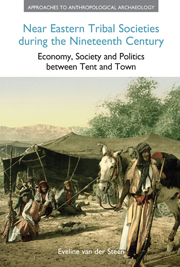
- This book is no longer available to purchase from Cambridge Core
- Publisher:
- Acumen Publishing
- Online publication date:
- March 2014
- Print publication year:
- 2013
- Online ISBN:
- 9781844657827
- Subjects:
- Archaeology: General Interest, Archaeology

Until the First World War, Near Eastern society was tribally organised. In the Levant and the Arabian peninsula, where the Ottoman empire was weak, large and powerful tribes such as the Anaze, Beni Sakhr and Shammar competed for control of the land, the people and the economy. This in-depth study explores the history, archaeology and anthropology of tribal society, economy and politics in the villages, towns and deserts of the Near East in the nineteenth century. Drawing on a wide range of historical accounts from travellers, adventurers and explorers as well as archaeological evidence, the book sheds new light on tribal life and tribal organisation as a driving force in Near Eastern society. While a straight comparison between ancient and more recent tribal communities must be treated with caution, the book shows how a better understanding of nineteenth-century tribal ethics and customs provides useful insights into the history and power relations of the more distant past and the underlying causes for the present conflicts of the region. The book is an important addition to new research on Bedouin life and culture and will be of interest to historians, archaeologists, anthropologists and scholars of the Near East.
 Loading metrics...
Loading metrics...
* Views captured on Cambridge Core between #date#. This data will be updated every 24 hours.
Usage data cannot currently be displayed.